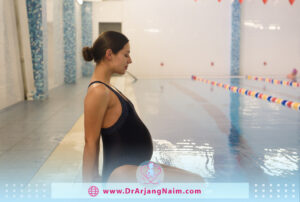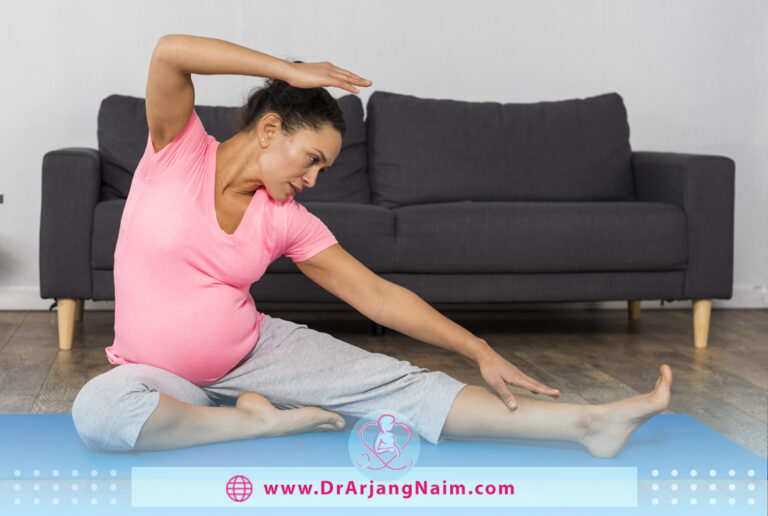Exercising during pregnancy is a beneficial practice that can contribute to the overall health and well-being of the expectant mother and the developing baby. Engaging in regular physical activity helps maintain a healthy weight, improves cardiovascular fitness, boosts mood, and promotes better sleep quality. Moderate-intensity exercises such as walking, swimming, and prenatal yoga are generally safe and can be adapted to accommodate the body’s changing needs. However, it is crucial to consult with a healthcare provider before starting or continuing an exercise routine during pregnancy to ensure it aligns with individual health conditions and to receive appropriate guidance and recommendations.

Exercise in pregnancy
Regularly exercising during pregnancy can help you stay healthy and feel good. Regular exercise during pregnancy can improve the condition and reduce common discomforts such as back pain and fatigue. There is evidence that physical activity can prevent gestational diabetes, reduce stress, and increase stamina for labor.
If you were physically active before pregnancy, you should be able to continue your activity in moderation. Do not try to exercise at your previous level. Instead, do what’s easier now. A pregnant competitive athlete should be closely monitored by an obstetrician.
If you’ve never exercised regularly before, you can safely start an exercise program during pregnancy after checking with your healthcare provider but don’t try any new, vigorous activity. It is considered safe to start walking during pregnancy.
The American College of Obstetricians and Gynecologists recommends getting 30 minutes or more of moderate exercise daily, most days or not all days unless you have a medical or pregnancy complication.
What are the benefits of exercise during pregnancy?
Exercising for 30 minutes most or all days can be good for your health during pregnancy. The important thing is to be active and get your blood flowing.
To be successful with exercise during pregnancy, it is a good idea to plan the days and times of the week that you will exercise. Prenatal yoga is a great, low-impact exercise that can be very beneficial for pregnant women. Here are some of the benefits of exercise during pregnancy that you may experience:
- Reduces back pain, constipation, flatulence and swelling
- May help prevent or treat gestational diabetes
- Increases energy
- Improves mood
- Improves posture
- Strengthening muscles, strength, and endurance
- It helps you sleep better
Regular activity also helps keep you fit during pregnancy and may improve your ability to cope with labor. This will help you get back to normal after your baby is born.
What types of activities are safe during pregnancy?
If your provider says it’s okay for you to exercise, choose activities you enjoy. Now is a good time to start if you didn’t exercise before pregnancy. Talk to your provider about safe activities. Start slowly and build up your fitness little by little. For example, start with 5 minutes of activity each day and work your way up to 30 minutes each day.
Walking
Brisk walking is a great exercise that does not stress the joints and muscles. If you are new to exercise, this is a great activity.

Swimming and water workouts
Water supports the growing baby’s weight, and moving against it helps keep the heart rate up. It is also good for joints and muscles. If you have back pain while doing other activities, try swimming.
Riding a stationary bike
A stationary bike is safer than regular cycling during pregnancy. You’re less likely to fall off a stationary bike than a regular bike, even as your belly gets bigger.
Yoga and Pilates classes
Tell your yoga or Pilates teacher that you are pregnant. A trainer can help you change or avoid positions that may be unsafe for pregnant women, such as lying on your stomach or flat on your back. Some clubs and community centers offer prenatal yoga and Pilates classes for pregnant women.
Strength training
Strength training can help you build muscle and strengthen your bones. Weight training is safe as long as they are not too heavy.
Starting exercise during pregnancy
Pre-exercise screening is used to identify people with medical conditions that may put them at higher risk of experiencing a health problem during physical activity.
Read the pre-exercise self-screening tool before starting a new physical activity or exercise program. If you are not allowed to exercise and participate in physical activity before pregnancy, it is recommended to:
- Do at least 30 minutes of moderate-intensity physical activity most days of the week.
- Let your body be your guide. Pay attention to the feeling of fatigue during the duration and intensity of exercise.
- If you are healthy and have no complications during your pregnancy, continue this level of activity throughout your pregnancy or until it becomes uncomfortable for you.
- Be directed by a doctor, physiotherapist, or healthcare professional.
Who should not exercise during pregnancy?
If you have a medical problem, such as asthma, heart disease, or diabetes, exercise may not be recommended. If you have conditions related to pregnancy, such as:
- Bleeding or spotting
- Low placenta
- Threatened or recurrent miscarriage
- Previous premature births or history of early labor
- Weak cervix
Talk to your doctor before starting an exercise program. They can also provide personalized exercise instructions based on your medical history.
Exercises to avoid while pregnant
During pregnancy, avoid sports and activities with increased risk or the following characteristics:
- Abdominal impact or pressure( such as lifting weights )
- Contact or collision (such as martial arts, football, basketball, and other competitive sports)
- Hard projectiles or impact tools (such as hockey, cricket, or softball)
- Falls (such as downhill skiing, horseback riding, and skating)
- Significant changes in pressure (such as diving)
- Heavy lifting
- Extreme balance, coordination and agility (such as in gymnastics)
- High-altitude training at more than 2000 meters
- Wide squats or lunges
- The exercise position is lying on the back (lying on the back); in this position, the weight of the child can slow down the return of blood to the heart. Some of these exercises can be modified by lying on your side.

Warning signs when exercising during pregnancy
If you experience any of the following during or after physical activity, stop exercising immediately and see a doctor:
- Headache
- Dizziness or feeling faint
- Heart palpitations
- Chest pain
- Swelling of the face, hands, or feet
- Calf pain or swelling
- Vaginal bleeding
- Contractions
- Amniotic fluid leakage
- Unusual shortness of breath
- Excessive fatigue
- Muscle weakness
- Deep back, pubicor pelvic pain
- Cramping in the lower abdomen
- Walking difficulties
- An unusual change in your baby’s movements
Pelvic floor exercises and pregnancy
Pelvic floor muscles weaken during pregnancy and birth, so it is very important to start preparing the pelvic floor muscles from the beginning of pregnancy.
Appropriate exercises can be prescribed by a physiotherapist. It is important to continue these during pregnancy and resume as soon as you are comfortable after delivery.
Abdominal exercises and pregnancy
Strong abdominal muscles support the spine. The abdominal muscles of the inner core and pelvic floor act as a natural “corset” to protect the pelvis and lumbar spine.
During pregnancy, it is common for women to experience a condition called diastasis recti, a painless midline split of the abdominal muscle, also known as abdominal separation. Traditional sit-ups or crunches may worsen this condition and are ineffective during pregnancy.
Proper central stability exercises are recommended during pregnancy to strengthen the abdominal muscles. For example:
- Focus on pulling the navel toward the spine.
- Breathe in while pulling in your stomach.
- Hold the position and count to 10. Relax and breathe.
- Repeat this 10 times, as many times a day as you can.
- You can do this exercise sitting, standing, or on your hands and knees.
Stretching exercises for pregnancy
Stretching exercises soften and warm the muscles, which can be especially useful during pregnancy. Here are some simple stretches you can do before or after exercise:
- Neck rotation: Relax your neck and shoulders. Throw your head forward. Slowly turn your head to the right shoulder, back to the center, and over the left shoulder. Do four slow rotations in each direction.
- Shoulder rotation: Bring your shoulders forward and then roll them up toward your ears and back down. Make four turns in each direction.
- Swim: Place your arms at your sides. Raise your right arm and pull your body forward and twist to the side as if you were swimming in a backstroke. Follow with your left arm. Do the sequence 10 times.
- Thigh shift: Stand with one foot about 2 feet in front of the other, toes pointing in the same direction. Lean forward, keeping your weight on your front thigh. Switch sides and repeat. Do four on each side.
- Leg shake: Sit with your legs and feet extended. Move the legs up and down with gentle shaking movements.
- Ankle rotation: Sit with your legs extended and keep your toes relaxed. Rotate your legs, making big circles. Use the whole foot and ankle. Turn four times to the right and four times to the left.

Kegel exercises during pregnancy
Kegel exercises help to strengthen the supporting muscles of the bladder, uterus, and intestines. By strengthening these muscles during pregnancy, you can develop the ability to relax and control the muscles in preparation for labor and delivery.
Kegel exercises are also highly recommended during the postpartum period to improve the recovery of perineal tissues, increase the strength of the pelvic floor muscles, help these muscles return to a healthy state, and increase urinary control.
Try to do five sets of Kegel exercises a day. Slowly count to five each time you contract your pelvic floor muscles, and then relax. Repeat this 10 times for one Kegel set.
What changes in pregnancy may affect exercise?
Physical changes during pregnancy create additional demands on the body. Remember to listen to your body and adjust your activities or exercise program if necessary. These changes include:
- A growing child and other internal changes require more oxygen and energy.
- Hormones produced during pregnancy cause the ligaments that support the joints to stretch and increase the risk of injury.
- Excess weight and uneven weight distribution change the center of gravity. Extra weight also puts pressure on the joints and muscles of the back and hip area, making it easier for you to lose your balance.
Does pregnancy change the body’s response to exercise?
During pregnancy, the body changes in many ways. When you are active, you may notice changes in the following:
- Balance: You may find that you lose your balance more easily during pregnancy.
- Body temperature: Body temperature is slightly higher during pregnancy, so you sweat earlier than before.
- Breathing: As the baby grows and the body changes, it needs more oxygen. Your growing belly puts pressure on your diaphragm, the muscle that helps you breathe. You may even feel short of breath.
- Energy: Your body is working hard to take care of your baby, so you may have less energy during pregnancy.
- Heart rate: During pregnancy, the heart works harder and beats faster to deliver oxygen to your baby.
- Joints: During pregnancy, the body produces more hormones. This can relax the tissues that support the joints. Try to avoid movements that may put pressure on the joints or cause damage.
The bottom line
Exercising during pregnancy miraculously affects the health of the mother and child. Back pain, ankle swelling, insomnia, and many other pregnancy complications, and exercise are among the best ways to reduce these problems. Exercise during pregnancy significantly affects the health of the mother and fetus. Among the benefits of exercise during pregnancy, we can mention strengthening the mother’s spirit, reducing pregnancy complications, and influencing rapid postpartum recovery.
It is never too late to start training. Pregnancy can be a new beginning for your sports life. Paying attention to this point is important that you consult your doctor to choose the right exercise for your condition and its duration.
Additional questions
- Why is it important to continue exercising after the baby is born?
Exercising after a baby is born may help improve mood and reduce the risk of deep vein thrombosis (DVT), a condition that can occur more often in women in the weeks after giving birth. In addition to these health benefits, exercising after pregnancy can help you lose excess weight you may have gained during pregnancy.
- When can you exercise again after giving birth?
Talk to your healthcare provider to find out when it’s okay for you to get active again. If you had a normal birth without any complications, you can usually start exercising a few days after giving birth or as soon as you feel ready.
If you had a cesarean section or complications during labor, you may need to wait longer to start exercising after birth. Your provider can help you determine when your body is ready for exercise.
- What kinds of activities aren’t safe during pregnancy?
- Any activity that has a lot of jerkies, bouncing movements that may cause you to fall
- Any sport in which you can get hit in the belly
- Any exercise that makes you lie flat on your back
- Activities that can cause you to hit the water with great force
- Skydiving or scuba diving
- Exercising at high altitudes (more than 6,000 feet)
- Activities that may make your body temperature too high
- How much exercise do you need during pregnancy?
Healthy pregnant women need at least 2.5 hours of moderate-intensity aerobic activity per week. Aerobic activities make you breathe faster and deeper and make your heart beat faster. Moderate intensity means you’re active enough to break a sweat and increase your heart rate. Brisk walking is an example of moderate-intensity aerobic activity.
- At what week should you stop exercising during pregnancy?
If you have an uncomplicated pregnancy, staying active throughout the pregnancy is safe.
References
https://americanpregnancy.org/healthy-pregnancy/is-it-safe/exercise-during-pregnancy/
https://www.betterhealth.vic.gov.au/health/healthyliving/pregnancy-and-exercise
https://www.webmd.com/baby/guide/exercise-during-pregnancy
https://www.pregnancybirthbaby.org.au/exercising-during-pregnancy
https://www.acog.org/womens-health/faqs/exercise-during-pregnancy
https://www.nhs.uk/pregnancy/keeping-well/exercise/




